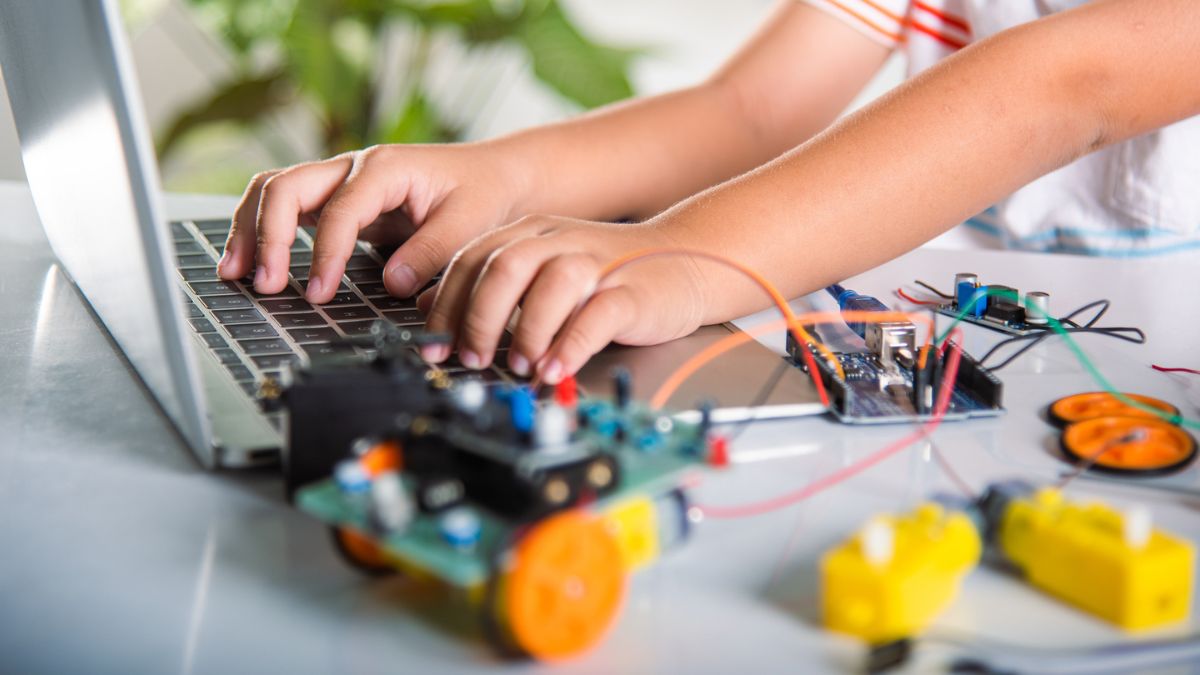Robotics for Kids: The Future With AI and Robotics Education

Robotics for kids is an exciting and engaging way to introduce children to the world of technology, engineering, and programming. By getting into this interactive field, kids can develop essential skills such as creativity, problem-solving, and coding. It’s never too early for kids to explore their curiosity for robotics, as various robotic toys and kits cater to different ages and interests.
Science, technology, engineering, and math (STEM) focused and clever robotic toys help kids understand the science behind circuits and motion and inspire them to take on more challenging projects in the future.
The Foundations of Robotics
When teaching kids about robotics, understanding the basics is the first part. Robotics is an exciting field combining STEM elements.
Let’s start with the core components that make up robotics:
- Mechanical Engineering: This aspect deals with robot design, construction, and operation. It involves understanding materials, structures, and mechanisms that enable robots to perform various tasks, such as moving, grabbing, and interacting with objects.
- Electrical Engineering: In this area, kids learn about electronic circuits and components that power robotic systems. They’ll explore topics such as voltage, current, and resistance, helping them grasp how electrical signals control a robot’s movements and functions.
- Computer Programming: At the heart of a robot lies its ‘brain’ – a computer or microcontroller that processes information and sends commands to its mechanical and electrical components. Kids can create code that brings a robot to life by learning programming languages like Scratch or Python.
With these components covered, kids can create robots, experimenting with other designs and functions.
Getting Started With Robotics
For beginners, it’s good to start with a simple design and building projects, like creating a bristlebot, a tiny robot made from a toothbrush head, a battery, and a small motor. This simple project introduces the basic concepts of robot design and encourages hands-on learning.
When explaining robotics to kids, maintain a casual tone and keep explanations relatable and straightforward. Encourage creativity, problem-solving, and critical thinking as crucial skills for thriving in robotics.
Choosing a Starter Robotics Kit
Consider investing in a starter robotics kit to make the initial jump enjoyable. Here are some popular options for various age groups:
- 6-9 years old:
- LEGO Education WeDo 2.0
- Dash Robot by Wonder Workshop
- 10-14 years old:
- mBot by Makeblock
- LEGO Mindstorms EV3
These kits typically come with clear instructions, software, and all the necessary components to build a functional robot. They offer a learning experience with simple, well-guided projects to help kids familiarize themselves with coding, electronics, and mechanics.
Considerations and Challenges in Robotics for Kids
While robotics offers kids an exciting gateway into technology and innovation, it will have some challenges and other considerations.
Firstly, the cost can be a significant factor; not all families can easily access expensive robotics kits or resources. It’s vital to explore cost-effective alternatives or seek out community programs that provide access to robotics education. Robot kits have a wide price range, from beginner to more complex, so there is a right fit for every family.
Additionally, supervision is crucial, especially for younger children. Working with electronic components and programming requires guidance to ensure safety and practical learning.
Moreover, the learning curve varies from child to child. Some may grasp concepts quickly, while others need more time and patience. Recognizing these challenges helps us approach robotics education for children in a more supportive way, ensuring that every child can explore and learn at their own pace.
Digging Deeper Into Robotics
For kids, programming is vital in helping them understand how to give robots the intelligence and capabilities to perform the desired tasks. Kids can start by learning block-based programming languages like Scratch, which provide an easy way to grasp coding concepts without syntax complexity.
Children can explore more advanced programming languages like Python and Java as they progress. Python is a versatile language favored by many for its readability and ease of use. In contrast, Java, though more complex, is widely used in various industries and provides a solid foundation for further learning.
This is a list of programming languages that can be used in robotics:
- Scratch (block-based)
- Python
- Java
The Science Behind Robotics
Understanding science will help kids to comprehend robotics fully. The science behind robotics involves various fields, such as artificial intelligence (AI), machine learning, and mechanical engineering. By grasping these concepts, kids can further enhance their robotic creations and make them more advanced and efficient.
AI and machine learning, in particular, have been instrumental in making robots more adept at mimicking human behavior and learning from their environments. These technologies allow robots to analyze large data sets and draw new insights, enabling them to adapt and grow over time.
For instance, comparing AI, machine learning, and robotics can be as follows:
- Artificial Intelligence (AI)
- Key Focus: Simulating human intelligence in machines
- Application in Robotics: Decision-making and pattern recognition
- Machine Learning
- Key Focus: Algorithms that learn from data and improve over time
- Application in Robotics: Autonomously adapting to new scenarios
- Robotics
- Key Focus: Design, construction, and operation of robots
- Application in Robotics: Physical implementation of AI and machine learning concepts
Taking Robotics to the Next Level
For kids who have already mastered the basics of robotics, various advanced projects can help them further deepen their understanding. By participating in more complex projects, they’ll enhance crucial skills like problem-solving, coding, and engineering.
Some advanced project ideas include:
- Walking robots: Designing a robot that can walk using servo motors, microcontrollers, and sensors
- Remote-controlled robots: Building a robot that can be controlled wirelessly through a smartphone or a custom remote control
- Autonomous robots: Creating a self-driving robot that can navigate using different sensors, like ultrasonic or infrared
These projects provide a great learning experience and allow kids to showcase their creations to the community by sharing videos, participating in online forums, and entering robotics competitions.
Robotics in Real-Life Applications
Robotics isn’t just a fun hobby – it’s a growing field with a wide range of real-life applications that have the potential to make an immense impact. Here are some examples of where robotics is playing a vital role:
- Self-driving cars: Companies like Tesla and Waymo are working on fully autonomous vehicles that rely on advanced robotics and artificial intelligence. Introducing kids to robotics can increase their interest in the technology powering these cars.
- Manufacturing: Robotics is transforming the manufacturing industry by automating tasks, improving efficiency, and reducing the risk of human injuries. Familiarizing kids with robotics can prepare them for career opportunities.
- NASA: Robotics is playing a significant role in space exploration, too. NASA uses robots like the Mars rovers to collect and analyze data from other planets, helping scientists learn more about our solar system.
Taking robotics to the next level helps kids hone their skills and exposes them to the vast possibilities of applying their knowledge to real-life scenarios.
The Future of Robotics
In the coming years, we anticipate many breakthroughs in robotics and AI technology, leading to the development of more advanced and user-friendly robots. These innovations will significantly impact people’s everyday lives, including kids, who will grow up surrounded by technology and automation.
Children should be introduced to robotics at a young age or whenever they show interest in how things work. Encouraging kids to study topics related to robotics, AI, and technology will equip them with the necessary skills and spark their curiosity and creativity.
Here are some aspects kids can focus on:
- Coding: Learning to code helps build a strong foundation for understanding and interacting with robots and AI systems
- STEM education: Science, Technology, Engineering, and Mathematics are essential fields that contribute to advancing robotics and AI
- Problem-solving: Developing critical thinking and problem-solving skills will enable kids to adapt to and understand the complexities of future technology
Integrating robots and AI will play a significant role in various sectors, such as education, healthcare, and transportation.
For kids, this might translate into classrooms becoming more interactive with AI-driven teaching assistants that can customize learning experiences. Additionally, robotic toys could engage and stimulate creativity while teaching programming and other skills. There would also be a greater emphasis on technologically driven extracurricular activities, including robotic clubs and competitions.
As we wrap up, it’s clear that robotics isn’t just an excellent hobby for kids; it’s a window into a future filled with exciting possibilities. It’s more than just coding and gears; it sparks curiosity, builds problem-solving skills, and opens doors to creativity.
There are hurdles like cost and the need for guidance, but these are small compared to the enormous benefits. By giving kids a head start in robotics, we’re not just keeping them busy with a fun activity. We’re preparing them for a world where technology is everywhere. And who knows? Today’s kids tinkering with robots could lead to the next big tech revolution.
This article originally appeared on Wealth of Geeks.






